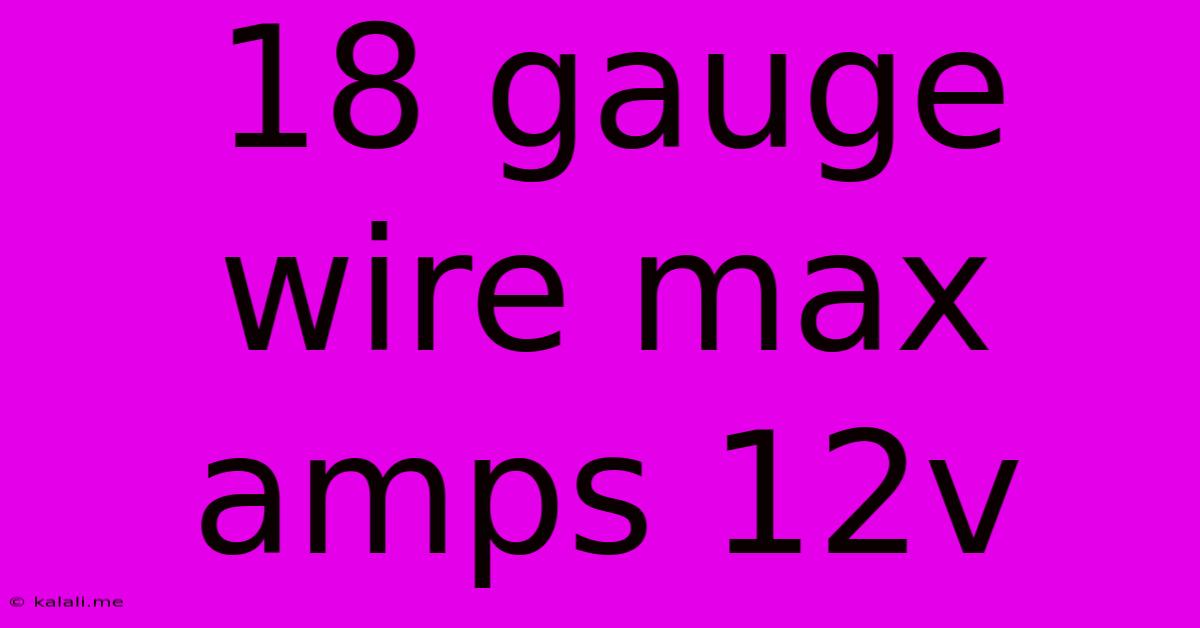18 Gauge Wire Max Amps 12v
Kalali
May 30, 2025 · 3 min read

Table of Contents
18 Gauge Wire: Max Amps at 12V and Important Safety Considerations
Determining the maximum amperage an 18 gauge wire can safely handle at 12 volts is crucial for any electrical project. Underestimating this can lead to overheating, fire hazards, and equipment damage. This article will explore the safe ampacity of 18 gauge wire at 12V, along with vital safety precautions and factors influencing its current-carrying capacity.
Understanding Ampacity and Wire Gauge
Ampacity refers to the maximum amount of current (amperes or amps) a wire can continuously carry without overheating. Wire gauge, expressed as a number (like 18 gauge), indicates the wire's diameter – the smaller the gauge number, the thicker the wire, and therefore the higher its ampacity. 18 gauge wire is relatively thin, limiting its current-carrying capacity.
18 Gauge Wire Ampacity at 12V: The Short Answer
While a definitive answer depends on several factors (discussed below), a commonly cited safe ampacity for 18 gauge wire at 12V is approximately 10 amps. However, this is a conservative estimate, and operating at or near this limit consistently is risky. Aiming for a lower amperage usage is always recommended for safety and longevity.
Factors Affecting 18 Gauge Wire Ampacity:
Several factors can influence the actual ampacity of 18 gauge wire:
- Insulation Type: Different insulation materials have varying heat resistance. Thicker insulation typically allows for higher ampacity.
- Ambient Temperature: Higher surrounding temperatures reduce the wire's ability to dissipate heat, lowering its safe ampacity.
- Wiring Length: Longer wires experience more voltage drop, leading to increased heat generation and reduced effective ampacity.
- Conduit/Grouping: Running wires within conduits or bundled together increases heat buildup, decreasing the safe ampacity.
- Airflow: Adequate airflow around the wire helps dissipate heat, improving its ampacity.
Safety Precautions When Using 18 Gauge Wire:
- Always Use Appropriate Connectors: Ensure proper connection to prevent loose connections that could overheat.
- Avoid Overloading: Stay significantly below the maximum ampacity to allow a safety margin.
- Regular Inspection: Regularly inspect the wires for any signs of overheating, such as discoloration or melting insulation.
- Fuse Protection: Incorporate fuses or circuit breakers rated appropriately for the circuit's amperage to prevent overcurrent situations.
- Proper Installation: Follow all relevant electrical codes and best practices during installation.
Calculating Current Draw:
Before using 18 gauge wire, accurately calculate the current draw of your devices. Add up the amperage ratings of all devices that will be connected to the circuit. This total amperage should be significantly lower than the wire's safe ampacity.
Choosing the Right Gauge Wire:
If your project requires higher amperage, consider using a thicker wire gauge with a higher ampacity rating. It's always better to err on the side of caution and use a larger gauge wire than to risk damage or a fire hazard.
Conclusion:
While a commonly used guideline suggests a 10-amp limit for 18 gauge wire at 12V, safety should be the top priority. Consider all influencing factors and significantly derate the ampacity to ensure reliable and safe operation. Never push the wire to its absolute limit. Using a thicker gauge wire when in doubt is always the safer approach. Remember to consult local electrical codes and regulations before undertaking any electrical project.
Latest Posts
Latest Posts
-
How To Manually Drain A Washing Machine
Jun 01, 2025
-
Where Does The Notary Stamp Go
Jun 01, 2025
-
6 Of 1 Half A Dozen Of Another
Jun 01, 2025
-
Does Yellow And Blue Make Green
Jun 01, 2025
-
How To Create A 1 To Many Relationship In Access
Jun 01, 2025
Related Post
Thank you for visiting our website which covers about 18 Gauge Wire Max Amps 12v . We hope the information provided has been useful to you. Feel free to contact us if you have any questions or need further assistance. See you next time and don't miss to bookmark.